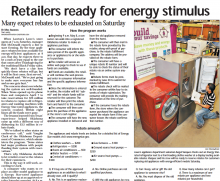
Installing additional attic insulation in your Lawton area home can reduce your heating and air conditioning costs by as much as 10%, according to ENERGY STAR. But before you begin this home improvement and money-saving project, make sure you have answered these three questions.
How much attic insulation does your home currently have?
Insulation is measured in R-values and the higher the R-value, the more resistant it is to heat flow (and therefore the more efficient it is.) In order to know how much insulation you need to add, you should first determine the R-value of the insulation currently in your attic.
How to determine your attic’s current R-value:
Determine the type of insulation in your attic. The most common types are cellulose, loose-fill fiberglass, and fiberglass batt (pictured above).
Measure the depth of your insulation in several places and take an average.
Multiply that number by the R-value per inch for the type of insulation you have. Cellulose is about R3.5, loose-fill fiberglass is R2.5, and fiberglass batt is R3.5
This will give you your attic insulation’s current R-value. For example, if there is an average of 4 inches of cellulose insulation throughout your attic, your current R-value is about R14.
Energy Star recommends an insulation rating or R30 to R60 for Lawton area homes. Therefore, in our example, since you already have 4 inches of insulation you should add 6 to 14 inches of insulation (R20 to R50) in your attic. Again, the higher the R-value, the more efficient the insulation is and the more you will reduce your energy costs.
Will you DIY or hire a professional to install the insulation?
Making the decision to do-it-yourself or hire a professional can be difficult. Remember to consider how much time you have to devote to the project. If you decide to go the DIY route, many home improvement stores will lend you the equipment to install loose-fill insulation as long as you meet a minimum purchase amount.
Be sure not block your attic’s soffit vents or you could create a major heat and moisture problem, and actually make your home less comfortable and efficient.
What materials will you be using?
Now that you have determined how much insulation you need and if you will be doing the installation yourself, the next step is to decide on the type of insulation you will install. Below are the three most common attic insulation types for DIY projects.
Cellulose - Cellulose attic insulation is made from recycled wood fibers (like newspapers). It is a loose-fill type of insulation. Unlike fiberglass, it will not irritate your skin, throat or eyes. It has a higher R-value per inch than fiberglass loose-fill but also tends to settle more.
Loose-fill fiberglass - Loose-fill fiberglass typically has a lower R-value than both fiberglass batt and cellulose. However, it can be easier to install than fiberglass batt and does not settle as much as cellulose. Fiberglass can be very irritating to your skin, eyes and throat.
Fiberglass batt - Fiberglass batt comes in rolls or short rectangles. These batts fit nicely between wood studs but are more difficult to maneuver around things like chimneys, vents and light fixtures. Also, fiberglass can be very irritating.
Once you have answered these three questions, you are now ready to install or purchase attic insulation for your Lawton area home. This guide from ENERGY STAR can be especially helpful for the installation process, if you have decided to DIY.
If you would rather improve your home’s comfort and energy efficiency quickly and easily, contact Pippin Brothers for a no cost, no obligation quote to upgrade your home’s insulation.








